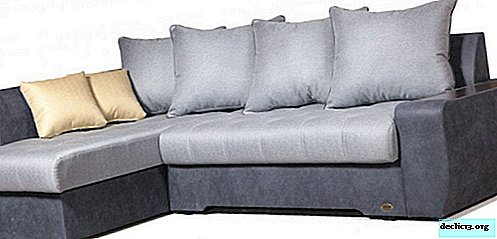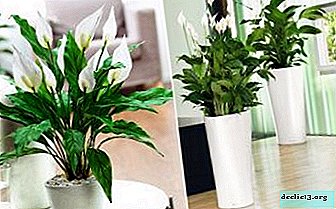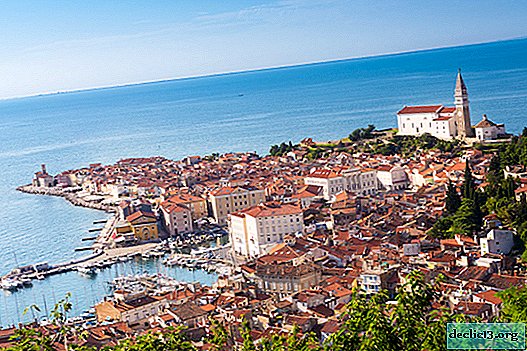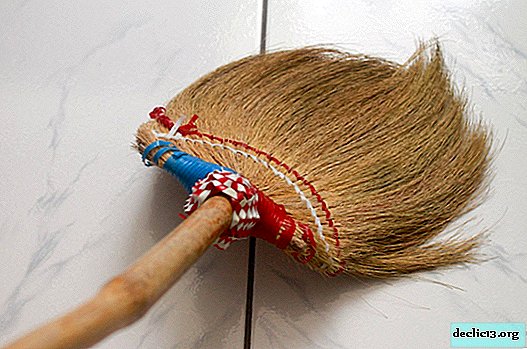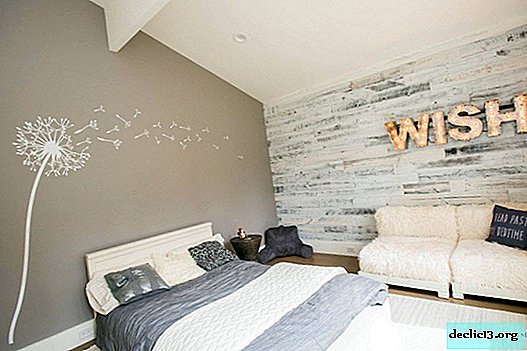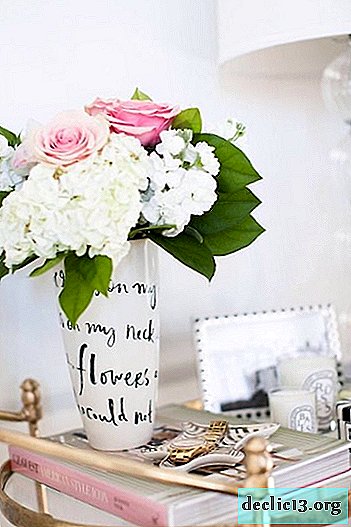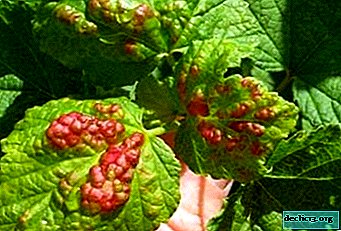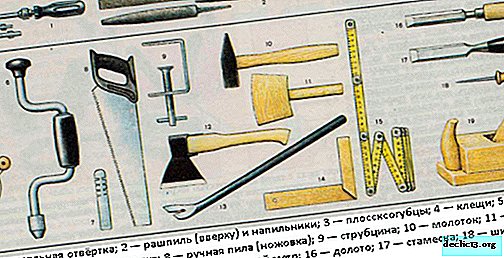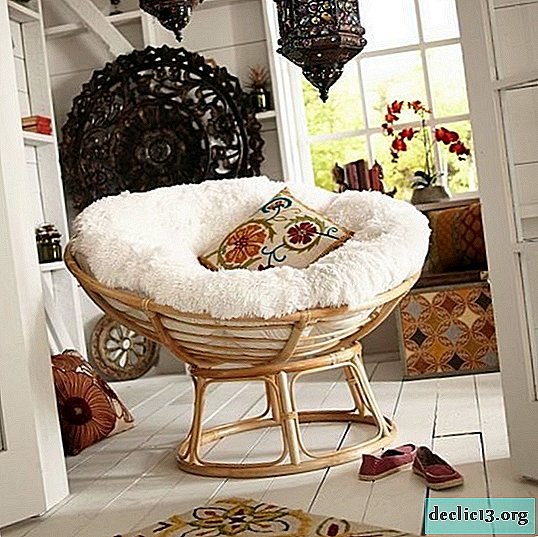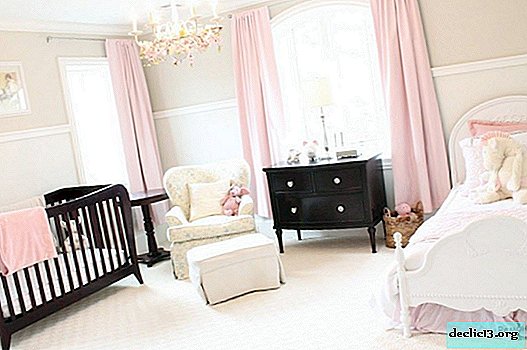Description of the appearance of a houseplant - metal begonias: care features and other nuances
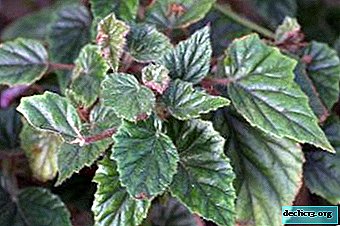
If you decide to green your apartment or greenhouse with a large beautiful representative of the flora - then pay attention to the metal begonia. This plant is very unpretentious in care, it does not need a lot of light and it has lush leaves and delicate flowers that will delight your eye for many years.
How to properly keep this flower at home, what procedures and care measures will make it possible to make begonia always serve as a real decoration of the interior? All this and much more will be discussed in this article.
Botanical Description and History
Metallic begonia (Begonia metallica) is a representative of the begonia family (Begonia) and belongs to the type of decorative-deciduous plants of this genus. This name is given to this plant because of the color of its leaves: on the front side, its leaves are greenish-olive in color, and red veins have a metallic tint. Also This type of begonias is called telecotsvetnaya or metallic.
On a note. It is believed that the genus begonia (begonia) is named after the governor of Haiti, who was a great connoisseur and collector of flowers, M. Begon, who lived in the 18th century.Despite the fact that a great wealth of begonia plants is observed in the tropical zone of South America and Asia, begonia has been imported to the countries of Europe and Russia for a long time. Metal begonia is native to Brazil, where in nature it lives on dark or humid hills at an altitude of 800-1700 m above sea level in pine and deciduous forests.
Description of appearance
Telesvetnaya begonia - a large plant with a highly branched pubescent stem. The leaves of this plant are dark green in color with pronounced red veins that have a metallic sheen. These leaves, which reach 15 cm in length, are asymmetrical in shape with serrated edges and have a pubescent surface.
The reverse side of the sheet is purple. With proper care, begonia grows very quickly and reaches 80-120 cm in height. In autumn and summer, many large fluffy flowers appear on the plant, with a delicate white and pink color.
Photo
Below you can see a wonderful houseplant - metal begonia.



Where and how to plant it: rules, tips and instructions
Metallic begonia - a beautiful indoor plant that tolerates dimming well and, unlike most indoor flowers, it can be located in the darkened part of the apartment. In addition, this is a representative of the flora, whose sizes sometimes exceed a meter, and its stems branch strongly and grow down, so it is recommended to put it on a stand to emphasize the attractiveness of leaves and inflorescences.
Reference. However, when choosing a place for metal begonias, you need to consider that it does not tolerate drafts and high humidity.Also, a balcony is not suitable for growing this plant, because the flower does not tolerate large temperature differences and does not like it when it is often transferred from one place to another.
Other species of this plant can make up a contrasting background on a stand for leaves of a metal begonia: for example, begonia is ever flowering or winter begonia.
Lighting and location
Telegonous begonia prefers diffused saturated light or is in partial shadetherefore putting it on the windowsill on the south side of the room is not preferred. The leaves of this flower are very sensitive to direct sunlight, from which the leaves themselves may turn yellow, or burns may appear on them. The eastern, northern or western side of the room will be optimal for her, also this plant will look great on the stand.
Soil requirements
Metal begonia should be transplanted once a year, preferably in the spring. Also, the plant needs a transplant immediately after purchase in order to consider whether the roots are healthy and whether there are pests on them.
 The soil for begonia is better to choose a multi-component, loose and nutritious. The composition of the soil should include:
The soil for begonia is better to choose a multi-component, loose and nutritious. The composition of the soil should include:
- Sheet earth.
- Peat.
- Humus land.
- Sod land.
- Sand.
The pot for transplanting adult plants must be chosen large and wide, because in a cramped pot the leaves of the metal begonia begin to fade, and the plant will not be as magnificent as before.
Important! Be sure to put drainage at the bottom of the pot, expanded clay or fine pebbles are perfect as drainage, otherwise the roots of the flower may begin to rot due to excess moisture, which will lead to the death of the flower.Softer soil should be used to plant young plants.: you need to mix peat and leaf or sandy land equally. Initially, young seedlings are planted in small pots with a diameter of 8 cm, and then, when the plant takes root, it is planted in a large tray.
How to care?
Metallic begonia is an unpretentious plant in its care, however, it does not like large temperature differences from which a flower can lose its leaves. This thermophilic plant prefers an air temperature of 16 - 25 degrees, and in winter the temperature should not be lower than 15 - 16 degrees, but at a temperature above 20 degrees it is recommended to place begonia in a darker part of the room.
The plant loves high humidity, but it should be ensured that there is no stagnation of moisture, which will lead to the appearance of fungi. Despite the love of moisture - metal begonia does not like water leaves. Watering in winter should be moderate, and in summer you should water begonia abundantly.
When watering, it is better to focus on the soil: if it dries by 1.5 cm, the plant needs watering. It is necessary to water it with warm water, defended for 1 day, a little citric acid can be added to the water. If in winter it is not possible to maintain the temperature above 15 degrees, then you need to water the flower with warm water, and put even warmer water near the pallet, while the top layer of the soil must be loosened by 1 cm.
Common Diseases and Pests
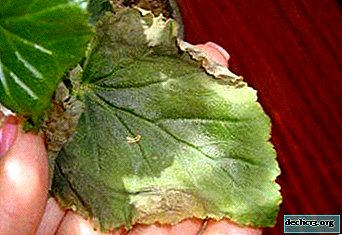 Burns on the leaves. Symptoms: burns on the leaves of a metal begonia occur due to direct sunlight, especially if splashing in the sun on leaves of water. Treatment: the plant should be removed from direct sunlight.
Burns on the leaves. Symptoms: burns on the leaves of a metal begonia occur due to direct sunlight, especially if splashing in the sun on leaves of water. Treatment: the plant should be removed from direct sunlight.- Rotting of the stem at the root. Symptoms: the stem begins to rot at the very base, the leaves fall down. This is a consequence of too high a temperature or excessive watering. Treatment: it is necessary to reduce watering and remove the plant to a cooler place.
- The defeat of the plant with Botrytis cinerea. Symptoms: gray mold (dark brown lesions) appears on the leaves, flowers and stalk. Such a disease appears due to high humidity. Treatment: Ventilation should be improved, but drafts should be avoided.Reference. Be sure to let the plant dry, and then use the necessary fungicides for treatment.
- The defeat of the plant by the fungus Oidium begoniae. Symptoms: white powdery mildew appears on the leaves, the smell of the fungus is also present, after the mold spreads, the leaves are crowded, followed by the death of the plant. Such a disease is caused by high humidity at a temperature of 20 - 24 degrees. Treatment: just like with the previous fungus, it is necessary to improve ventilation, avoiding drafts, let the begonias dry out and treat with the help of fungicides.
- Viral infection. Symptom: yellow spots appear on the leaves. Treatment: this disease cannot be cured, you must immediately destroy the plant so that the disease does not spread to other indoor plants.
Propagation Features
Metal begonia can be propagated by dividing the rhizome and seeds, but the most common method of propagation of this plant is propagation by stem cuttings. This method should be propagated in spring or summer.
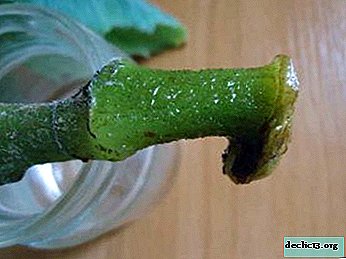 From non-flowering begonia stems, cuttings of 8-10 cm in length should be cut. Lower the tips of the cuttings into hormonal powder.
From non-flowering begonia stems, cuttings of 8-10 cm in length should be cut. Lower the tips of the cuttings into hormonal powder.- Plant the cuttings in prepared pots with a diameter of 8 cm. In the soil, consisting of peat and sand in a ratio of 1: 1. After planting, cover the pots with plastic wrap to create a greenhouse.
- After about 6 weeks, leaves will appear on the cuttings, before that, the cuttings should be protected from bright light. After the leaves appear, the film must be removed.
- Transplant the young plant into a larger pot in the soil for an adult plant.
Conclusion
Begonia metallica, like most plants of this genus, has long adapted to the climate of Russia. Telesvetnaya begonia is very easy to care for and unpretentious in planting conditions. Its content will not be difficult, and its beautiful magnificent asymmetric leaves can be enjoyed for several years.

 Burns on the leaves. Symptoms: burns on the leaves of a metal begonia occur due to direct sunlight, especially if splashing in the sun on leaves of water. Treatment: the plant should be removed from direct sunlight.
Burns on the leaves. Symptoms: burns on the leaves of a metal begonia occur due to direct sunlight, especially if splashing in the sun on leaves of water. Treatment: the plant should be removed from direct sunlight. From non-flowering begonia stems, cuttings of 8-10 cm in length should be cut. Lower the tips of the cuttings into hormonal powder.
From non-flowering begonia stems, cuttings of 8-10 cm in length should be cut. Lower the tips of the cuttings into hormonal powder.